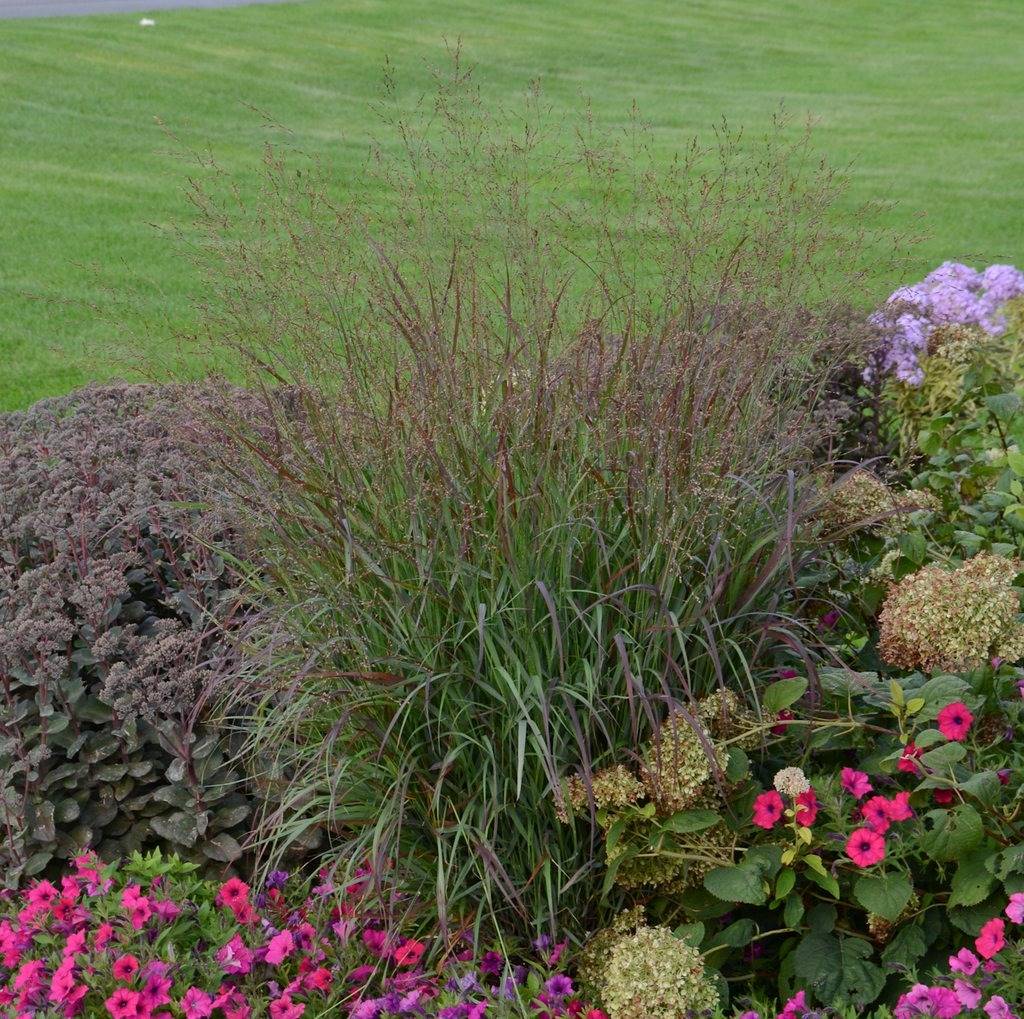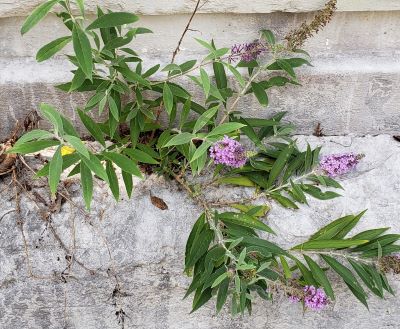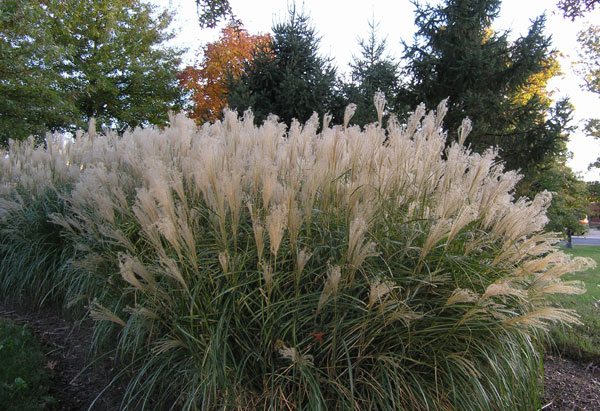When it comes to texture, movement, and year-round interest in the garden, few plant groups rival ornamental grasses. They bring elegance, structure, and softness to planting designs—from naturalistic meadows to modern borders. But gardeners today are faced with a choice: native ornamental grasses or non-native ornamental grasses. While both can look beautiful, native species offer advantages that go far beyond appearance.

Native Ornamental Grasses for the Garden and Landscape
Many non-native ornamental grasses have proven to be aggressively invasive in North American landscapes. Miscanthus sinensis (Chinese silver grass), Pennisetum setaceum (fountain grass), Cortaderia selloana (pampas grass), and Imperata cylindrica (Japanese Blood Grass), are some of the most widely planted ornamental grasses, all now declared invasive or widely recognized as such in parts of the US.
In contrast, native grasses are generally clump-forming and well-behaved. They tend to stay where you plant them, playing nicely with other garden plants and posing no threat to local ecosystems. Unlike non-natives, native grasses provide critical food and shelter for a wide range of birds, butterflies, bees, and other beneficial insects. Some butterflies and moths use native grasses as host plants for their larvae, while seed-eating birds flock to them in fall and winter.
There's a native ornamental grass to rival and replace almost any non-native variety. With so many heights, textures, and colors to choose from, native grasses can enhance any design style, from sleek and sculptural to wild and romantic. Most are just as drought tolerant once established as non-natives due to their deep, extensive root systems. They can perform the same functions in the landscape, including privacy screening, foundation plantings, specimen accents, hellstrip plantings and erosion control.
Native ornamental grasses really came into their own in the 21st century, with breeders and consumers alike realizing the benefits and beauty of species like Panicum virgatum (Switchgrass) and Schizachyrium scoparium (Little Bluestem). While formerly relegated to ecological restoration and erosion control projects, these hardy plants have finally gained a foothold in home gardens.Their use has further increased with the recent popularization of meadow style gardens focused on natural aesthetics, wildlife value, and ease of maintenance.
Still however, garden centers are full of miscanthus and fountain grass, and they're still the most prevalent species of ornamental grasses found in landscapes across the country. Many gardeners may be less familiar with native ornamental grasses, but there's no reason to fear! If you're considering adding grasses to your landscape, or even replacing some of your non-native species, read on to discover the virtues of native ornamental grasses and how they can enhance your home and garden.
Native Ornamental Grass Species in Commerce:
Breeders have concentrated so far on cultivars of switchgrass and little bluestem, selecting for color and sturdy, non-flopping habits. Big Bluestem and Indiangrass are seeing increased interest and more varieties are undoubtedly on the horizon.

Below: Little bluestem (Schizachyrium scoparium) cultivar 'Jazz' is a perfect fit for smaller gardens, and can be used in hot, sunny gardens where non-native fountain grasses might often be planted. Photo courtesy Greenleaf Nursery, www.greenleafnursery.com

Below: Big Bluestem, a lesser-known native species of ornamental grass. Andropogon gerardii 'Dancing Wind' is a big bluestem cultivar with yellow-green red accented leaves that turn deep red in late summer.

Below: Pink muhly grass creates a fluffy pink explosion in the late summer to fall garden. Here, native Muhlenbergia reverchonii 'Undaunted' lives up to its catchy moniker. Photo courtesy Ball Horticulture, www.ballhort.com

Native Switchgrass: Panicum virgatum culture and cultivars
Best grown in full sun as it may flop in partial shade. Splitting may also occur in too-fertile soil. Plant in average, dry to moist, well-drained soil--both clay and sandy soil are acceptable. Tolerates drought once established and periodic flooding and coastal conditions; often used in rain gardens. Zones 4-9.
Cultivars:
- 'Totem Pole': 5-6'; very strong vertical habit; grayish-blue-green; golden seed heads and tan fall color; 2.5' wide
- 'Cheyenne Sky': 2.5-3'; compact size for smaller gardens and containers, upright clump; deep red color by midsummer
- 'Heavy Metal': 3-5'; metallic blue; dense, vase-shaped, extremely upright clump; yellow-orange fall color
- 'Niagara Falls': 4' x 4'; powder blue; dense, compact with arching foliage on upright habit; large & showy cream seedheads; probably the best of the panicums to replace a similarly-sized Miscanthus, as the arching leaves and wider growth offer a similar fountain-like appearance.
- 'Half Pint': 3' x 1.5-2.5'; green with rosy red seedheads; very compact, dense, upright; bright golden yellow fall color
- 'Gunsmoke': 4-5' x 3-3.5'; steely blue foliage; wider than others, dense, upright; large, airy, showy, smoky plum inflorescences followed by tan seedheads cover the plant for a great display
- 'Apache Rose': 4' x 2.5'; gray-green, tipped with rosy red in fall; vertical upright; large, rosy flower panicles are very attractive
'Northwind': 4-5', blue-green; very tight, upright clump; stays neat, spreads slowly; golden-tan fall color; rated a top performer in Chicago Botanic Garden trials, noted for it's strong verticality
'October Sky': 4.5-5' x 2-2.5'; blue-green; upright; sturdier than 'Northwind' and a bit taller and with seedheads more purple than 'Apache Rose'
- 'Prairie Dog': 3-4'; silvery gray-blue with rosy inflorescences; upright habit 2-3' wide
- 'Dallas Blues': 5-6' x 3'; blue-gray; wider leaves and broader, arching habit, but can be floppier than other varieties; smoky pink flower panicles; good for screening
- 'Hot Rod': 3-4' x 2': blue-green turning burgundy in summer earlier than many other varieties; red flower panicles
- 'Shenandoah': 3-4'; soft-edged upright habit; slower growing; green with red tips, deepening to burgundy late season; rich red-purple fall foliage; one of the first "red" cultivars
- 'Prairie Sky': 4-5', one of the bluest varieties, powdery blue to blue-gray; upright and slightly arching habit; fall color tan to golden-bronze
- 'Rostrahlbusch': 3-4'; upright, graceful and airy; green turning to red in summer; burgundy fall color
- 'Blue Fountain': 6-8' x 5-6' steely blue-gray with yellow fall color and tall wispy flowerheads; very upright and non-flopping; fast growing - good substitute for large miscanthus types or used for screening
- 'Cloud Nine': 7-8' x 4-6'; blue-green turning gold in fall; dense, arching, vase-shaped non-flopping habit;large airy flower panicles; height and habit makes it excellent for screening
Little Bluestem: Schizachyrium scoparium culture and cultivars
Schizachyrium scoparium, commonly known as Little Bluestem, is a compact, upright native warm-season bunchgrass prized for its cultivars with blue-green summer foliage that progressively deepens to tones of red and purple in late summer to fall. It’s one of the most versatile native grasses, especially well-suited for smaller gardens, pollinator landscapes, and naturalistic plantings. It supports several varieties of native butterflies and provides seeds for songbirds. The species is green with a blue-tinged base turning bronzy in fall, usually growing 2 to 4 feet.
This is an ideal low-maintenance plant for small urban gardens, especially for gardeners leaning toward newer meadow style designs where "full-on" meadow gardens might be frowned upon. The fine, narrow foliage adds wonderful texture to perennial beds and borders, and the spiky inflorescences persist well into winter. Its resilience in poor soils makes it a natural choice for hot, dry gardens and hell-strip plantings. In general, these are upright clumps with a softening fringe of arched foliage at the base.
Plant in full sun and well-drained soil; adaptable to sandy, rocky, clay, or low-fertility soils. May flop in partial shade or rich soil. Must have good drainage, especially over winter. Heat and humidity tolerant and very drought tolerant once established. Cut back to 2 inches in spring once signs of new growth are evident. Zones 3-9.
Cultivars:
- 'Jazz': 24-30" x 12-18"; silvery blue changing to coppery rust in fall; purple bronze flowers with silvery seed heads; upright clumping habit
- 'The Blues': 2-4' x 1.5-2'; blue foliage with pinkish stems turns burgundy in fall; upright clump.The one that started it all--many newer cultivars are sports of this variety.
- 'Twilight Zone': 4-4.5' x 2'; silvery mauve-purple cast over the green foliage by midsummer, with purple stems in fall; upright clump
- 'Blue Paradise': 3-3.5' x 2'; silvery blue in summer becoming wine purple in fall; strongly upright clump
- 'Prairie Blues': 3-3.5' x 1.5-2'; gray blue with bronzy-orange fall color; strongly upright clump
- 'Blue Heaven': 2-4' x 1.5-2.5'; blue-gray foliage with purple summer highlights and burgundy-red fall color, bronzy in winter; upright clump, less prone to flopping; violet & golden
- 'Smoke Signal': 3-4' x 2'; blue-green in spring with deep red tones in late summer, becoming purple in fall; strong upright clump; tan seed heads in early fall
- 'Cinnamon Sticks': 32-36" x 24-26"; blue foliage begins to turn color earlier than other varieties, becoming deep cinnamon by fall; very upright clump
- 'Chameleon': 2' high (18" when not in flower) x 1' wide; green and white vareigated foliage flushes pink to light purple in summer and fall. One of very few native variegated grasses.
- 'Standing Ovation': 2-4' x 1.5-2'; blue-green foliage with red tips progresses to silvery blue with soft pink to red and orange shades in fall, holding very late into the season; rigidly upright clumping habit, less prone to flopping than 'The Blues'
- 'Carousel': 2 to 2.5' high and wide; blue-green with reddish purple, copper, and mahogany tones; broader, rounder habit than other little bluestems; a top performer in Chicago Botanic Garden trials
Big Bluestem: Andropogon gerardii culture and cultivars
Andropogon gerardii, commonly known as Big Bluestem, is one of the most iconic native prairie grasses in North America. once covering much of the Midwest. Known for its height, durability, striking fall color, and persistent winter seed heads, it’s an excellent choice for naturalistic gardens, wildlife habitat, and even as a tall ornamental feature in the landscape. The somewhat "see-through" appearance makes it especially striking when backlit by the sun, and allows it to be planted in mid-garden positions rather than being relegated to the background.
This low-maintenance native grass thrives on neglect, needing only only full sun and well-drained soil, and is adaptable to a range of soils including sandy and clay. Tolerant of drought, heat, humidity, air pollution, and planting near black walnut. Breeding has focused on improved color, form, and more compact varieties suitable for smaller landscapes. As with other native grasses, partial shade and overly rich soil may result in flopping. Their three-parted flower clusters are said to resemble turkey feet. Zones 3-9
Cultivars:
- 'Blackhawks': 4-5' x 1 to 2'; deep green maturing to burgundy and nearly black; narrowly vertical, upright clumping habit; selected seedling of 'Red October.'
- 'Holy Smokes': 4-6' x 2-3'; silvery blue-green in spring with red stems in summer becoming shades of smoky purple, burgundy, and orange in fall and through winter; upright habit with arching leaves
- 'Red October': 5-6' x 2-3'; deep green summer foliage becomes purplish red in late summer, turning scarlet red in fall; upright clump; burgundy red inflorescences in late summer; selected seedling of 'Indian Warrior'
- 'Lord Snowden': 5-8' x 4-8'; bright powder blue foliage with reddish purple, pink, and copper tones developing in late summer; vertical, upright, and better furnished at the base than some othe cultivars
- 'Indian Warrior': 5-6' x 1-2'; green with a burgundy sheen come midsummer with deep purple flowers; top performer in Chicago Botanic garden trials
- 'Windwalker': 5-6'; blue-green with burgundy tones in fall; strong upright habit
- 'Dancing Wind'; 4.5-5.5' x 2.5-3'; yellow-green summer foliage with red accents turns deep fiery red in late summer and fall; more upright habit than 'Indian Warrior'
Indiangrass: Sorghastrum nutans & Blue Grama Grass: Bouteloua gracilis - culture and cultivars
Sorghastrum nutans,commonly known as Indiangrass, is a tall, warm-season, clump-forming native prairie grass that’s highly ornamental and ecologically valuable. It’s easy to grow once established and offers year-round interest with striking fall color and winter persistent seed heads. Perfect for naturalistic and wildlife-friendly landscapes and soil stabilization, smaller cultivars also provide an interesting accent to traditional beds and borders. Like other native grasses, ornamental breeding has focused on stronger, non-flopping upright habits and improved color. Zones 3-9.
Plant in full sun to retain best upright habit and color, although light shade is tolerated. Adaptable to almost any well-drained soil, including sandy, loamy, or clay. Drought tolerant once established, but also grows well in moderately moist soil. As with most native ornamental grasses, overly rich soils may cause flopping.
Cultivars:
- 'Golden Sunset': 5-6' x 2-3'; green foliage with 10-12" golden wheat-like seedheads in late summer; strong vertical and upright clumping habit with arching leaves at base
- 'Indian Steel': 3 to 5' x 2-3'; blue-green leaves turn yellow in fall; tan-yellow flowers rise high above the foliage in late summer, turning bronze in fall and persisting into early winter; upright, open clump
- 'Sioux Blue': 3-6' x 2-3'; metallic blue half-inch wide leaves with cinnamon flowerheads; yellow fall color that may remain gold in winter; excellent vertical clumping habit; foliage usually grows to 3' with flowering stems adding the additional height
Bouteloua gracilis, commonly known as Blue Grama, is a charming, low-growing (1-2 feet) native warm-season bunchgrass that’s perfect for dry, sunny landscapes. It's well-known for its quirky eyelash-shaped seed heads, fine-textured blue-green foliage, and adaptability to tough growing conditions. A key species in shortgrass prairies, it’s increasingly popular in low-maintenance ornamental landscapes, xeriscaping, and naturalistic gardens. Zones 3-10.
Give it full sun and very well-drained soil. Performs best in lean soil, so no fertilizer. Tolerant of sandy, rocky, or clay soils as long as excellent drainage is provided. Will disappear completely in winter, so you may want to mark the space so as not to disturb when working beds in spring. Can be mowed to 2-3 inches high, so can be used as an informal lawn substitute. Perfect for hot, dry, difficult sites and erosion control on sunny slopes.
Cultivars:
- 'Blonde Ambition': Taller than the species at 30-36' high and wide; fine-textured blue-green foliage with unique chartreuse horizontally held seedheads on stiff stems in fall that remain into winter; upright clumping habit
Other Native Grasses Valuable for the Home Garden and Landscape
- Pink Muhly Grass (Muhlenbergia capillaris and Muhlenbergia spp. and hybrids): Fine-textured wiry green foliage is topped with a spectacular cloud of pink flowers in autumn. While attractive as a specimen, it truly shines when massed. Prefers full sun (although tolerates light shade) and dry to medium well-drained soil. Sandy, rocky, poor soils are not a problem. Tolerates heat, humidity, and drought but does better with adequate moisture. Forms a 2-3' rounded, upright mounded clump. One of the best plants for fall interest. 'White Cloud' is a white flowering variety if you're not feeling in the pink. Zones 5-11.
- Northern Sea Oats (Chasmanthium latifolium): 2-5' x 1-2.5'; upright green foliage; grown for the winter-persistent drooping seedheads that flutter in the breeze. Tolerates more shade, fertility, and moisture than many other native ornamental grasses. Grow in average to wet soil in sun to part shade. Self-seeds and can quickly colonize an area, so best for larger gardens and naturalized areas or woodland edges. Zones 3-8.
- Prarie Dropseed (Sporobolis heterolepis): 2-3' high and wide; fine-textured arching green foliage forms a fountain-like, rounded clump; turns bronzy gold in fall and has excellent winter substance; airy late summer and fall pinkish-tan flowerheads have a fragrance compared variously to coriander, licorice, or popcorn. A very effective substitute for smaller fountain grasses. Grow in full sun and well-drained, average to dry soil. Heavy clay, drought, occasional flooding, and planting near black walnut is tolerated. Seed is eaten by songbirds; does not freely self-sow, so can be used in perennial borders. 'Tara,' is a dwarf form growing to 12 inches (24" in flower) with a vase-shaped, upright habit and orange-red fall color. Zones 3-9.
- Purple Lovegrass (Eragrostis spectabilis): 1-2' high and wide; typically grown for the airy reddish-purple late summer inflorescences and for xeriscaping; green 1/4" wide foliage usually up to 10" high in a loose clump. Grow in full sun in dry or average well-drained soil. Prefers hot, dry sites and sandy or gravelly loam soils. Tolerates drought and infertile soil. May self-seed or spread by rooting at nodes, so perhaps best in naturalized areas, dry meadow gardens, and hellstrip plantings. Zones 5-9.








































